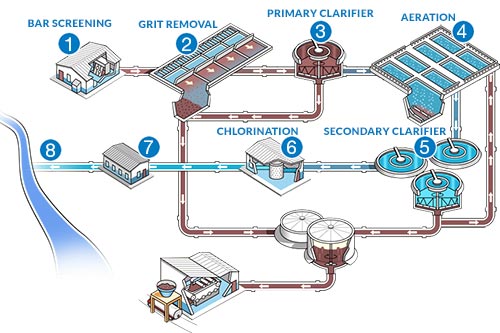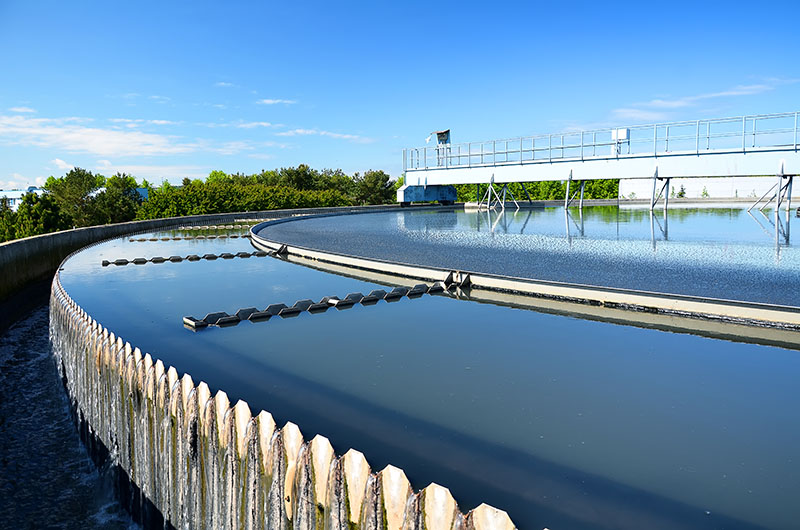How Wastewater Treatment Can Enhance Water Reuse Opportunities
Comprehending Wastewater Therapy Processes and Their Environmental Effect
The intricacies of wastewater treatment processes play a crucial role in mitigating ecological obstacles linked with water air pollution. Each phase, from initial to sophisticated treatments, is designed to address specific contaminants, inevitably guarding both public wellness and water environments.
Introduction of Wastewater Treatment
How is wastewater changed right into a risk-free resource for the setting? Wastewater therapy is an important process developed to remove impurities from made use of water, consequently protecting public health and shielding ecosystems. This process starts with the collection of wastewater from property, industrial, and business resources, which is after that routed to therapy facilities.
At these centers, different physical, chemical, and organic techniques are employed to deal with the wastewater. Preliminary testing removes large particles, complied with by sedimentation to separate heavier solids. Ultimately, biological therapies, such as activated sludge procedures, make use of microorganisms to damage down raw material. These approaches not just decrease contaminant degrees but additionally facilitate the healing of beneficial nutrients.
The treated effluent can be securely released into all-natural water bodies or recycled for irrigation and industrial objectives, promoting resource preservation. In addition, the treatment procedure creates biosolids, which can be repurposed as fertilizers or soil modifications, further improving sustainability.
Phases of Therapy Processes
The wastewater treatment process commonly includes three key phases: preliminary, primary, and additional therapy. Each phase offers a distinct role in minimizing the toxin load and guaranteeing the effluent satisfies ecological criteria before discharge.
The main therapy stage focuses on the physical separation of suspended solids from the wastewater. With sedimentation, much heavier bits work out at the bottom of sedimentation tanks, forming sludge, while lighter materials, such as oils and greases, float to the surface area and are skimmed. This procedure dramatically lowers the natural and not natural tons in the wastewater.
Additional treatment is a biological process intended at more minimizing the focus of raw material. Different approaches, including turned on sludge systems and trickling filters, utilize microorganisms to metabolize natural contaminants. This stage is important for achieving the essential biochemical oxygen need (BODY) reduction, eventually leading to cleaner effluent all set for discharge or more therapy. Each stage is critical in safeguarding ecological and public wellness.

Advanced Therapy Technologies
Adhering to the additional treatment processes, progressed therapy innovations play a vital function in additional boosting the high quality of dealt with wastewater. These innovations are made to remove recurring contaminants that are not effectively eliminated throughout primary and additional treatments, guaranteeing the effluent satisfies strict regulative standards.
Among the widely made use of innovative therapy methods are membrane layer filtering, reverse osmosis, and progressed oxidation processes. Membrane purification, including microfiltration and ultrafiltration, works in separating fine bits, microorganisms, and colloids from the water (Wastewater). Reverse osmosis makes use of semi-permeable membrane layers to eliminate liquified solids, causing top notch water appropriate for numerous applications
Advanced oxidation processes (AOPs) use solid oxidants to weaken organic toxins, consisting of pharmaceuticals and personal treatment products that are resistant to traditional treatment. These methods enhance the biodegradability of intricate compounds, facilitating their removal.
Another significant innovation is using organic nutrient removal processes, which especially target nitrogen and phosphorus, preventing eutrophication in receiving water bodies. On the whole, innovative treatment technologies are important for achieving higher degrees of filtration, advertising water reuse, and safeguarding public health and wellness while dealing with the obstacles linked with wastewater management.
Ecological Advantages of Treatment
Many environmental benefits arise from effective wastewater treatment procedures that add to ecosystem health and wellness and sustainability. Mainly, these processes considerably lower the release of harmful contaminants into natural water bodies, which assists preserve marine environments. By removing contaminants such as hefty steels, nutrients, and virus, dealt with wastewater alleviates the threat of waterborne illness and advertises biodiversity in aquatic environments.
In addition, wastewater treatment centers commonly utilize advanced technologies that make it possible for water recycling and reuse. This technique not only conserves fresh water resources yet likewise reduces the need on natural water products. Improved nutrient why not look here elimination from wastewater can likewise prevent eutrophication, a procedure that results in algal blossoms and subsequent oxygen deficiency in aquatic systems.
In addition, efficient therapy processes can decrease greenhouse gas emissions, specifically methane and nitrous oxide, which are typically launched during without More Help treatment wastewater decay. By recording and utilizing biogas from anaerobic digesters, centers can transform waste into eco-friendly energy, therefore adding to a reduction in fossil gas dependence.
Obstacles and Future Fads
While the ecological benefits of wastewater treatment are clear, a number of obstacles continue that prevent optimal outcomes in this field. One major issue is maturing facilities, which often causes inadequacies and enhanced operational prices - Wastewater. Several treatment plants were developed years earlier, and their capabilities do not align with contemporary needs, that include more stringent regulatory standards and higher volumes of wastewater because of urbanization

Looking in advance, there is a growing focus on source healing and circular economic situation principles within wastewater treatment. Technologies such as anaerobic food digestion, which can produce biogas, and progressed purification innovations are gaining grip. These techniques not only boost treatment performance however also advertise sustainability.
Eventually, dealing with these obstacles needs collaboration amongst stakeholders, investment in modern technology, and a commitment to recurring research study. By welcoming these patterns, the wastewater therapy market can evolve to satisfy the demands of an altering environment and society.
Verdict
To conclude, wastewater therapy processes play an essential role in boosting environmental high quality and public wellness. The multi-stage treatment structure, coupled with sophisticated modern Read Full Article technologies, efficiently minimizes pollution and advertises lasting water management. By attending to residual pollutants and decreasing nutrient overflow, these procedures add to the preservation of marine ecosystems and the reduction of greenhouse gas discharges. Proceeded advancements and adaptations in therapy approaches will certainly be important for getting rid of arising obstacles and guaranteeing the sustainability of natural sources (Wastewater).